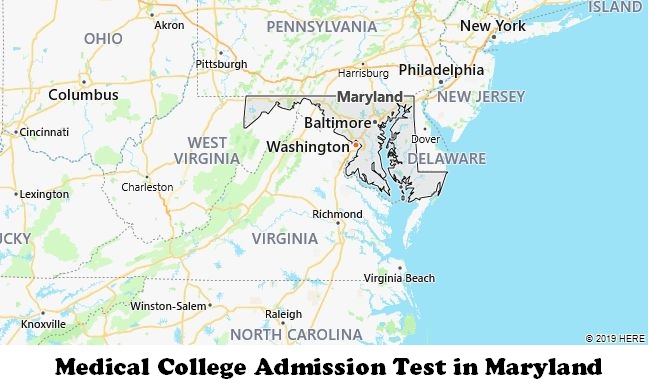According to AAMC (the MCAT test maker), there are 9 MCAT test centers in Maryland. Most testing centers are located inside a college or university. You can select a testing location that is nearest to you. Please note that you are able to choose a test center when registering for the MCAT.

Washington DC – Bethesda
8120 WOODMONT AVENUE
SUITE 510
BETHESDA, MD 20814
Washington DC – Bethesda
8120 WOODMONT AVENUE
SUITE 510
BETHESDA, MD 20814
Baltimore – Lord Baltimore Drive
2505 LORD BALTIMORE DRIVE
SUITE D-E
Baltimore, MD 21244
Baltimore – South Clinton Street
1501 South Clinton St.
13th Floor, Canton Crossing
Baltimore, MD 21224
Baltimore – Columbia
6304 WOODSIDE COURT
COLUMBIA, MD 21046
ETS – FROSTBURG STATE UNIV.
FROSTBURG STATE UNIVERSITY
PULLEN HALL RM 105A
FROSTBURG, MD 21532
Washington DC – Landover
4301 Garden City Dr
Suite 203-Metro 400
Landover, MD 20785
Prometric Test Center
1336 Belmont Ave. Suite 501B
East Park Professional Ctr.
Salisbury, MD 21804
Baltimore – Towson
8601 LaSalle Road
Suite 106
Towson, MD 21286

Recent History of Maryland
In 1689, after the “Glorious Revolution” in England, an uprising broke out again in Maryland. The Puritan militia, who made up the majority of the residents of the colony, defeated the governor’s troops. A new government was created, and Catholicism was outlawed (religious freedom was practically restored only after the American Revolution and the creation of the United States of America). Another result of the “Puritan rebellion” was the abolition of the charter that granted the land of Maryland to the possession of the Calvert family, now the colony was ruled directly by the English crown.
In 1694, the capital of Maryland was moved from Saint Mary City to Providence, renamed Annapolis.
Benedict Calvert, Charles Calvert’s son and heir, understood that religious affiliation was the main reason for dispossessing a family of ownership of Maryland. In 1713, he converted to Anglicanism, thereby causing extreme discontent of his father. In February 1715, after the death of Charles Calvert, Benedict, who became the fourth Baron Baltimore, turned to King George I with a request to return the overseas colony to the family. Although Benedict Calvert survived his father by only two months, his request was granted and already in May 1715, the fifth Baron Baltimore Charles Calvert again became the owner of Maryland.
In the thirties of the XVIII century, border disputes between Maryland and Pennsylvania led to an armed conflict, called the “Cresup War” after Thomas Cresap, who played an important role in the events. At the time, Maryland agents, including Cresap, were actively campaigning for colonists to settle on the west bank of the Susquehanna River, in an area disputed by both colonies. The authorities of Pennsylvania, dissatisfied with the expansion of their southern neighbor, in turn encouraged the settlement of disputed lands. Tensions mounted and led to a series of clashes involving Maryland and Pennsylvania militias. In 1737, King George II ordered a cessation of hostilities, and in May 1738 a treaty was signed in London, according to which the boundary was recognized as a line fifteen miles south of Philadelphia.
The boundary dispute was finally settled in the 1860s, when the sixth (and last) Baltimore Baron Frederick Calvert, who inherited the title in 1751, became the owner of Maryland. For four years, from 1763 to 1767, English surveyors Charles Mason and Jeremiah Dixon marked out the boundary between Virginia, Delaware, Maryland and Pennsylvania, known as the “Mason-Dixon Line”.
In the 18th century, slave labor began to be widely used on the plantations of Maryland, as in other southern colonies. Maryland’s population grew from about 25,000 in 1700 to over 130,000 in 1750, nearly half of them black slaves. Tobacco continued to be the main crop, but gradually the central and northern regions of Maryland became major producers of wheat. The port of Baltimore, founded in 1729, was the second most important in the south (after Charleston in South Carolina).
